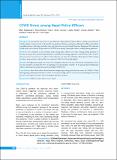Please use this identifier to cite or link to this item:
https://hdl.handle.net/20.500.14356/1120Full metadata record
| DC Field | Value | Language |
|---|---|---|
| dc.contributor.author | Rajbhandari, Bibek | - |
| dc.contributor.author | Tiwari, Bhuwaneshwar | - |
| dc.contributor.author | Gurung, Minani | - |
| dc.contributor.author | Poudel, Lisasha | - |
| dc.contributor.author | Adhikari, Anurag | - |
| dc.contributor.author | Shilpakar, Olita | - |
| dc.contributor.author | Puri, Rajesh Raj | - |
| dc.contributor.author | Singh, Sumi | - |
| dc.date.accessioned | 2023-04-24T08:16:09Z | - |
| dc.date.available | 2023-04-24T08:16:09Z | - |
| dc.date.issued | 2021 | - |
| dc.identifier.citation | RajbhandariB., TiwariB., Gurung M., Poudel L., Adhikari A., ShilpakarO., PuriR. R., & SinghS. (2021). COVID Stress among Nepal Police Officers. Journal of Nepal Health Research Council, 19(2), 390-395. https://doi.org/10.33314/jnhrc.v19i2.3672 | en_US |
| dc.identifier.issn | Print ISSN: 1727-5482; Online ISSN: 1999-6217 | - |
| dc.identifier.uri | http://103.69.126.140:8080/handle/20.500.14356/1120 | - |
| dc.description | Original Article | en_US |
| dc.description.abstract | Abstract Background: In Nepal, the stress factor is exacerbated by a large number of police officers working away from home with less family contact, a hectic work schedule in a pandemic situation, companions suffering from illness and updates on additional cases with rising mortality rates, and a lack of access to Personal Protection Equipment. The main aim of this study was to identify the prevalence of COVID stress among Nepal police officers working during pandemic. Methods: We conducted a cross-sectional study among police officers (n=1526) working during pandemic in Province X Nepal. Semi-structured questionnaire was administered using google form. COVID Stress Scale -36 (CSS-36) was used to assess the stress in officers. Data collection was done after obtaining ethical approval. Data cleaning was done using a python script and then was exported to Ms. Excel for graph analysis. Results: The highest percentage was seen in the xenophobia subscale (24.63%), followed by contamination (20.10 %) and compulsive checking (19.21%). Comparing socio-demographic variables, 18-27 aged groups including male officers and unmarried groups had experienced high COVID stress. Conclusions: Most of the officers feared from the foreigners perceiving them the main source of COVID-19. Fears about getting contaminated related to COVID-19 was also seen high. There is a need to assess psychological issues and provide social support to police officers during this pandemic situation. Keywords: COVID-19; police officer; stress; Nepal | en_US |
| dc.language.iso | en | en_US |
| dc.publisher | Nepal Health Research Council | en_US |
| dc.relation.ispartofseries | Apr-June, 2021;3672 | - |
| dc.subject | COVID-19 | en_US |
| dc.subject | police officer | en_US |
| dc.subject | stress | en_US |
| dc.subject | Nepal | en_US |
| dc.title | COVID Stress among Nepal Police Officers | en_US |
| dc.type | Journal Article | en_US |
| local.journal.category | Original Article | - |
| Appears in Collections: | Vol. 19 No. 2 (2021): Vol 19 No 2 Issue 51 Apr-Jun 2021 | |
Files in This Item:
| File | Description | Size | Format | |
|---|---|---|---|---|
| 3672-Manuscript-23788-1-10-20210908.pdf | Fulltext Download | 364.12 kB | Adobe PDF |  View/Open |
Items in DSpace are protected by copyright, with all rights reserved, unless otherwise indicated.
